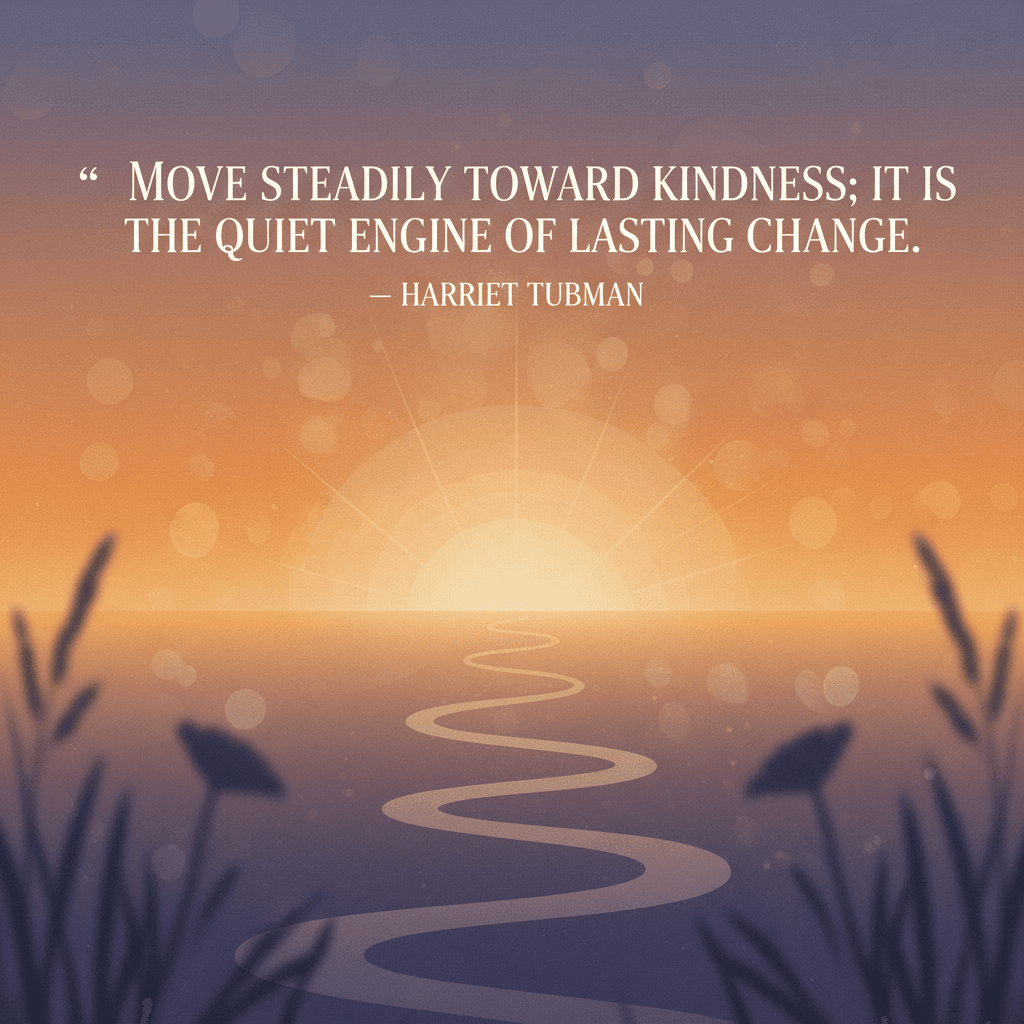Steady Kindness, the Engine of Lasting Change

Move steadily toward kindness; it is the quiet engine of lasting change. — Harriet Tubman
The Discipline Behind Gentle Power
At first glance, the line urges a shift from dramatic gestures to steady, humane action. By coupling movement with kindness, it frames change not as a sudden rupture but as an enduring arc shaped by character. Although this wording is commonly attributed to Harriet Tubman and lacks a definitive primary-source citation, the sentiment aligns with the quiet rigor that sustained abolitionist work. Thus, the quote proposes a paradox: gentleness is not weakness but a method. Like a well-tuned engine, kindness is underremarked yet propulsive, transforming outrage into organized persistence. This reframing prepares us to look past spectacle and toward practices that last.
Tubman’s Quiet Methods and Living Proof
In practice, Tubman advanced change through patient, repeated journeys that favored secrecy over applause. Working nights, she guided small groups along the Underground Railroad, returning again and again with calibrated care and tactical calm—an ethic that made rescue reproducible rather than theatrical. Frederick Douglass captured this spirit in his 1868 letter to Tubman, praising her deeds done where "the midnight sky and the silent stars have been the witnesses." The tribute underscores how quiet, steady courage—feeding, sheltering, reassuring, and navigating—became a reliable engine of freedom.
Networks Where Care Became Tactics
Moving from the individual to the collective, abolition hinged on webs of ordinary kindness turned into strategy. Quaker households, free Black communities, and Vigilance Committees offered what seemed modest—meals, clothing, directions, legal aid—but these acts formed a supply line for emancipation. William Still’s records in The Underground Railroad (1872) document such prosaic heroism, showing care as logistics. Because kindness lowers fear and raises trust, it also widens participation. Each safe bed and open door converted sympathy into structure. In this way, compassion ceased to be sentiment and became operational capacity.
Psychology: Why Kindness Scales and Sticks
Psychology helps explain why gentle means can yield durable ends. Barbara Fredrickson’s broaden-and-build theory (2001) shows that positive emotions expand attention and creativity, enabling people to spot options and build resources. Likewise, research on reciprocity (as popularized by Robert Cialdini) finds that generosity begets generosity, creating feedback loops that stabilize cooperation. Moreover, studies of prosocial behavior link small acts to lasting well-being; for example, Sonja Lyubomirsky and colleagues (2005) observed that regular kindness boosts happiness, which in turn sustains action. The result is compounding: caring acts grow networks, networks normalize care, and norms anchor change.
Building Durable Cultures of Care
Extending this logic to institutions, psychological safety—the shared belief that candor will not invite ridicule or punishment—correlates with learning and adaptability (Amy Edmondson, 1999). Policies that dignify people—clear communication, restorative responses to error, transparent decision-making—translate kindness into procedures that outlast any single leader. Because systems drift toward what they repeatedly practice, embedding care into rituals (welcomes, debriefs, peer support) makes compassion routine rather than exceptional. Once kindness is the default, improvement becomes cumulative rather than crisis-driven.
Steadiness Through Setbacks and Fatigue
Consequently, steadiness matters most when progress stalls. Research on nonviolent campaigns shows that broad, disciplined participation increases the odds of success and reduces backlash (Erica Chenoweth and Maria J. Stephan, 2011). Kindness aids that discipline: it invites joiners, repairs frayed ties, and softens zero-sum framing that can exhaust movements. At the personal level, self-compassion helps sustain effort without burnout; Kristin Neff’s work (2003) links self-kindness to resilience and wise persistence. In this light, moving steadily toward kindness is not only moral advice—it is a maintenance plan for momentum.